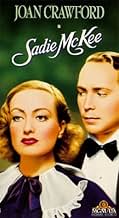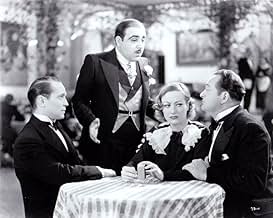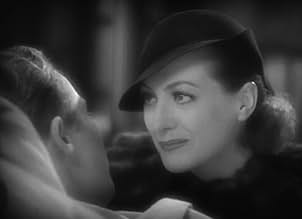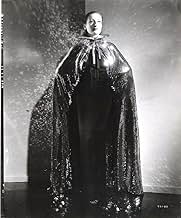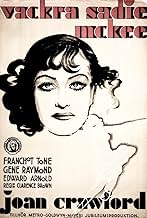AVALIAÇÃO DA IMDb
6,8/10
1,8 mil
SUA AVALIAÇÃO
Adicionar um enredo no seu idiomaA working girl's fortunes improve when she marries into money, but happiness is not so easily won.A working girl's fortunes improve when she marries into money, but happiness is not so easily won.A working girl's fortunes improve when she marries into money, but happiness is not so easily won.
- Direção
- Roteiristas
- Artistas
- Prêmios
- 3 vitórias no total
Leo G. Carroll
- Phelps
- (as Leo Carroll)
Candy Candido
- Cafe Entertainer
- (as Candy and Coco)
Otto Heimel
- Cafe Entertainer
- (as Candy and Coco)
Norman Ainsley
- Second Butler - at Downstairs Meeting
- (não creditado)
Hooper Atchley
- Intern with Dr. Briggs
- (não creditado)
Nellie Bly Baker
- Downstairs Laundress
- (não creditado)
Jack Baxley
- Short-Order Cook
- (não creditado)
- Direção
- Roteiristas
- Elenco e equipe completos
- Produção, bilheteria e muito mais no IMDbPro
Avaliações em destaque
Joan Crawford acts up a storm in this well done, interesting soap opera like story of working girl Sadie, daughter of a cook, who is madly in love with a loser named Tommy (played by Gene Raymond). Sadie and Tommy run off together to NYC where they soon take up residence in this shabby, one-room apartment. The next day, big plans for job hunting and a noon appointment at the city hall to get married, but unfortunately for Sadie, Tommy the Rat is thrown in the path of a bad blonde/singer named Dolly who hires him on the spot to sing in her act, they kiss and run off together leaving poor Sadie waiting at the so-called altar. But Sadie pulls herself up by her boot straps, gets a job as a dancer, and meets a multi-millionaire (Edward Arnold) with a big drinking problem, while still holding the torch for her beloved Tommy.
This film is quite a good one, the story completely held my interest, and the acting is top-notch with Joan Crawford giving out her full emotional range, Edward Arnold is excellent playing drunk for the majority of his scenes, and Esther Ralston does a good job as Dolly, the loose hipped, barely able to sing man-snatcher. Franchot Tone plays a lawyer, the son of the well-to-do home where Sadie was raised - he isn't given as much to do here as I would have liked but still gives a satisfying performance, and he certainly looks handsome enough, as usual. The film includes a few fun to watch musical numbers, plus some interesting scenes filmed in diners and a neat old-time Automat.
This film is quite a good one, the story completely held my interest, and the acting is top-notch with Joan Crawford giving out her full emotional range, Edward Arnold is excellent playing drunk for the majority of his scenes, and Esther Ralston does a good job as Dolly, the loose hipped, barely able to sing man-snatcher. Franchot Tone plays a lawyer, the son of the well-to-do home where Sadie was raised - he isn't given as much to do here as I would have liked but still gives a satisfying performance, and he certainly looks handsome enough, as usual. The film includes a few fun to watch musical numbers, plus some interesting scenes filmed in diners and a neat old-time Automat.
Joan Crawford is "Sadie McKee" in this 1934 film also starring Gene Raymond, Edward Arnold, Franchot Tone, and Jean Dixon. Crawford is the daughter of the cook for the wealthy Alderson family. The young man of the family, Michael (Tone) has obviously fallen for Sadie, but her heart belongs to loser Tommy Wallace (Raymond), who has just been fired for a malfeasance. Sadie runs off to New York with Tommy, and the two wind up in the rooming house of Mrs. Craney. The next day, they are to be married at City Hall at noon. But showgirl Dolly Merrick (Esther Ralston) who also lives at the rooming house, hears Tommy's dulcet tones and convinces him to forget marriage, leave town, and take a job in her traveling show.
Another women rooming at Mrs. Craney's is Opal, who gets Sadie a job at her club. There Sadie meets the filthy rich, drunken Jack Brennan, whom she marries. It turns out that Jack's drinking has all but destroyed his health. Though Sadie can't stop thinking about Tommy, she is determined to help Jack quit drinking and regain his health.
Pretty good melodrama, with Crawford wearing some fabulous outfits. Esther Ralston was a gorgeous blonde and is a lively Dolly Merrick, and Jean Dixon gives a good performance as Opal.
The debonair Franchot Tone gives a smooth performance as Michael, and Gene Raymond sings and acts pleasantly enough as Tommy, who manages to be likable though he walked out on Sadie.
Crawford made a lot of this type of film -- the working girl who moves up in class -- and they were very popular. She gives an appealing performance, and she was one actress who could look and act like a hard-working girl who came from a slum and also pull off being glamorous and wealthy.
Worth seeing.
Another women rooming at Mrs. Craney's is Opal, who gets Sadie a job at her club. There Sadie meets the filthy rich, drunken Jack Brennan, whom she marries. It turns out that Jack's drinking has all but destroyed his health. Though Sadie can't stop thinking about Tommy, she is determined to help Jack quit drinking and regain his health.
Pretty good melodrama, with Crawford wearing some fabulous outfits. Esther Ralston was a gorgeous blonde and is a lively Dolly Merrick, and Jean Dixon gives a good performance as Opal.
The debonair Franchot Tone gives a smooth performance as Michael, and Gene Raymond sings and acts pleasantly enough as Tommy, who manages to be likable though he walked out on Sadie.
Crawford made a lot of this type of film -- the working girl who moves up in class -- and they were very popular. She gives an appealing performance, and she was one actress who could look and act like a hard-working girl who came from a slum and also pull off being glamorous and wealthy.
Worth seeing.
This is often forgotten in Joan Crawford's filmography. It has lots of the ingredients of precode Hollywood, released a couple of month before the inception of the Production Code. It also has lots of the components of the films that Crawford made for MGM of the 1930s, but this one came relatively early in her career and thus seems fresh compared to later similar entries.
Sadie is the daughter of the cook in the home of the wealthy Alderson family. One night when helping out with the serving at dinner, she listens to the son and lawyer of the family (Franchot Tone as Michael) talking about how her boyfriend, Tommy Wallace, is a thief and should get no second chance from the community now that he's been fired from his job. Sadie tells them off and takes off with Tommy (Gene Raymond) to New York City. They have about twenty dollars between them, and pretend to be married to the landlady, planning to be married the next day. Sadie has a job interview, so she and Tommy agree to meet at city hall at noon and be married. He never shows. But this is not an Affair to Remember. Instead, it's exactly what you'd suspect. Brassy nightclub singer Dolly Merrick hears Tommy singing in the boarding house bathroom and offers him a job singing in her act. But the audition would conflict with his wedding. Tommy picks the audition over the wedding, clears out his clothes, and doesn't even leave a note behind.
Sadie, now a hardened jaded woman, gets a job dancing in a night club act where she meets the very wealthy Jack Brennan ( Edward Arnold). He's drunk when he meets her, drunk when he marries her, in fact the guy is perpetually drunk to the point I get tired of him, and it is so hard to get tired of the talented Edward Arnold. The complicating factor is that Michael Alderson is Brennan's lawyer, thinks the worst of Sadie, and is still a pompous glass bowl, although he was right about Tommy having no character. Sadie can't forgive him for that either.
Then comes the day when Sadie is told Brennan will die if he doesn't quit drinking, Sadie sees Tommy again and the old feelings surface, and Michael AND all of the servants think she is just a scheming tramp trying to let Brennan die drinking so she can become the rich widow. Complications ensue.
This film had lots of precode moments. There is the insinuation that Tommy and Sadie, in spite of their promises to each other to wait, do share a bed that one night they are in the rooming house. And there is the delightful Jean Dixon as Sadie's hard boiled friend who looks at the bedroom arrangements after Sadie marries Brennan and says "I've done a lot more for a lot less".
Recommended if it ever comes your way. It packs a lot of plot into its running time.
Sadie is the daughter of the cook in the home of the wealthy Alderson family. One night when helping out with the serving at dinner, she listens to the son and lawyer of the family (Franchot Tone as Michael) talking about how her boyfriend, Tommy Wallace, is a thief and should get no second chance from the community now that he's been fired from his job. Sadie tells them off and takes off with Tommy (Gene Raymond) to New York City. They have about twenty dollars between them, and pretend to be married to the landlady, planning to be married the next day. Sadie has a job interview, so she and Tommy agree to meet at city hall at noon and be married. He never shows. But this is not an Affair to Remember. Instead, it's exactly what you'd suspect. Brassy nightclub singer Dolly Merrick hears Tommy singing in the boarding house bathroom and offers him a job singing in her act. But the audition would conflict with his wedding. Tommy picks the audition over the wedding, clears out his clothes, and doesn't even leave a note behind.
Sadie, now a hardened jaded woman, gets a job dancing in a night club act where she meets the very wealthy Jack Brennan ( Edward Arnold). He's drunk when he meets her, drunk when he marries her, in fact the guy is perpetually drunk to the point I get tired of him, and it is so hard to get tired of the talented Edward Arnold. The complicating factor is that Michael Alderson is Brennan's lawyer, thinks the worst of Sadie, and is still a pompous glass bowl, although he was right about Tommy having no character. Sadie can't forgive him for that either.
Then comes the day when Sadie is told Brennan will die if he doesn't quit drinking, Sadie sees Tommy again and the old feelings surface, and Michael AND all of the servants think she is just a scheming tramp trying to let Brennan die drinking so she can become the rich widow. Complications ensue.
This film had lots of precode moments. There is the insinuation that Tommy and Sadie, in spite of their promises to each other to wait, do share a bed that one night they are in the rooming house. And there is the delightful Jean Dixon as Sadie's hard boiled friend who looks at the bedroom arrangements after Sadie marries Brennan and says "I've done a lot more for a lot less".
Recommended if it ever comes your way. It packs a lot of plot into its running time.
"Sadie McKee" was made just before Hollywood got serious about sanitizing its content, and the movie is set squarely in what we now call the pre-Code world. In this world, men are on the make, cops are on the take, rich people do pretty much as they please and prostitution is just another job option.
But while many other pre-Code film can leave you with a bleak feeling about human nature, this one is stocked with basically decent characters. Bribe-takers are just ordinary folks trying to get by. A clever seducer can't silence his own conscience. And when an aging, drunken millionaire orders up a young girl and takes her home for the night, the relationship quickly blossoms from exploitation into an odd kind of love.
Joan Crawford plays the title role, a plucky survivor whose ups and downs would have broken a lesser person. Gene Raymond, Franchot Tone and Edward Arnold play the three very different men in her life. The story is improbable at times, moving from flophouse to sleazy nightclub to mansion. But it's never gets so unrealistic that you stop caring. The ending is somewhat enigmatic, at least to me. I'm still wondering exactly where everyone stood at the end, and where things were headed. That's OK. I like a movie that leaves a little something nagging at you.
If the story is improbable, there's nothing unbelievable about how Joan Crawford's character turns men's heads. A lot of people still view Crawford through a "campy" lens, remembering her long years as a fading star with a lot of personal baggage (real and reputed). Forget all that stuff. In 1934 she was young and lithe and simply gorgeous. She carries this movie, and she carries it well.
But while many other pre-Code film can leave you with a bleak feeling about human nature, this one is stocked with basically decent characters. Bribe-takers are just ordinary folks trying to get by. A clever seducer can't silence his own conscience. And when an aging, drunken millionaire orders up a young girl and takes her home for the night, the relationship quickly blossoms from exploitation into an odd kind of love.
Joan Crawford plays the title role, a plucky survivor whose ups and downs would have broken a lesser person. Gene Raymond, Franchot Tone and Edward Arnold play the three very different men in her life. The story is improbable at times, moving from flophouse to sleazy nightclub to mansion. But it's never gets so unrealistic that you stop caring. The ending is somewhat enigmatic, at least to me. I'm still wondering exactly where everyone stood at the end, and where things were headed. That's OK. I like a movie that leaves a little something nagging at you.
If the story is improbable, there's nothing unbelievable about how Joan Crawford's character turns men's heads. A lot of people still view Crawford through a "campy" lens, remembering her long years as a fading star with a lot of personal baggage (real and reputed). Forget all that stuff. In 1934 she was young and lithe and simply gorgeous. She carries this movie, and she carries it well.
I'm a big fan of the Crawford oeuvre, in all its permutations and occasional excesses. That said, her Sadie is refreshingly underplayed and sincere. The mid-Atlantic accent that she tended to is at a minimum here, and there is a fluidity that is in much contrast to the Greek tragic masks, riveting though they are, of some of her later performances. The wonderful Jean Dixon is on hand in a role that is a precursor to Eve Arden's pal of "Mildred Pierce" and "Goodbye My Fancy"--worldly, rueful, self-denigrating. (Mary Phillips took on a similar part in "The Bride Wore Red" several years later.) Esther Ralston does a fine job as the blowsy, sensuous man-stealer--at one point she practically does a Mae West with her intonations and stance. Solid performances also from Franchot Tone and Gene Raymond and the always-reliable, under-appreciated Edward Arnold. The very engaging Earl Oxford appears as "the Stooge" and one wonders why this charmer did not have a film career.
The story is serviceable, and there is a motif of characters' taking responsibility for their lives, and, as best they can, making amends for wrongs. Note that at the start and end of the film there are scenes in which the camera follows a character from one room to the next in such a way that you realize that there is not any real partition between the two rooms--an enjoyable little breaking of the "fourth wall" premise of theater.
The story is serviceable, and there is a motif of characters' taking responsibility for their lives, and, as best they can, making amends for wrongs. Note that at the start and end of the film there are scenes in which the camera follows a character from one room to the next in such a way that you realize that there is not any real partition between the two rooms--an enjoyable little breaking of the "fourth wall" premise of theater.
Você sabia?
- CuriosidadesOne of the first films to treat alcoholism as a serious problem, instead of a comic device.
- Erros de gravaçãoWhen Tommy is in his hospital room he makes Dr. Briggs promise not to tell Sadie of his condition. However, when Dr. Briggs leaves the room, Sadie is there with the other doctors and she already knows. Dr. Briggs then says, "He made me promise he wouldn't tell her." This dialogue obviously makes no sense and is wrong. What he meant to say was, "He made me promise not to tell her."
- Citações
Sadie McKee Brennan: [showing off her bedroom] Here it is.
Opal: Lady, when you say, "I do take thee," how you take him.
Sadie McKee Brennan: [chuckles]
Opal: Got this all to yourself?
Sadie McKee Brennan: Yep, all to myself.
Opal: Always all to yourself?
Sadie McKee Brennan: Yep.
Opal: Well, a whole lot of us do a whole lot more for a whole lot less.
- ConexõesFeatured in O que Terá Acontecido a Baby Jane? (1962)
- Trilhas sonorasAll I Do Is Dream Of You
(1934) (uncredited)
Music by Nacio Herb Brown
Lyrics by Arthur Freed
Played during the opening credits
Sung by Gene Raymond three times
Sung also by Earl Oxford in a show
Principais escolhas
Faça login para avaliar e ver a lista de recomendações personalizadas
- How long is Sadie McKee?Fornecido pela Alexa
Detalhes
- Data de lançamento
- País de origem
- Idioma
- Também conhecido como
- Sadie McKee
- Locações de filme
- Empresa de produção
- Consulte mais créditos da empresa na IMDbPro
Bilheteria
- Orçamento
- US$ 612.000 (estimativa)
- Tempo de duração1 hora 33 minutos
- Cor
- Proporção
- 1.37 : 1
Contribua para esta página
Sugerir uma alteração ou adicionar conteúdo ausente

Principal brecha
By what name was Três Amores (1934) officially released in India in English?
Responda
